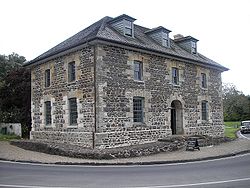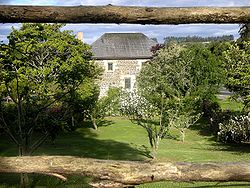
Stone Store
Encyclopedia

Kerikeri
Kerikeri, the largest town in the Northland Region of New Zealand, is a popular tourist destination about three hours drive north of Auckland, and 80 km north of Whangarei...
in the Bay of Islands
Bay of Islands
The Bay of Islands is an area in the Northland Region of the North Island of New Zealand. Located 60 km north-west of Whangarei, it is close to the northern tip of the country....
is New Zealand
New Zealand
New Zealand is an island country in the south-western Pacific Ocean comprising two main landmasses and numerous smaller islands. The country is situated some east of Australia across the Tasman Sea, and roughly south of the Pacific island nations of New Caledonia, Fiji, and Tonga...
’s oldest surviving stone building.
Part of the first Church Missionary Society station in New Zealand, the store was designed by John Hobbs to replace an earlier wooden store house. The Stone Store was erected between 1832 and 1836 by mason
Masonry
Masonry is the building of structures from individual units laid in and bound together by mortar; the term masonry can also refer to the units themselves. The common materials of masonry construction are brick, stone, marble, granite, travertine, limestone; concrete block, glass block, stucco, and...
William Parrott, carpenter Ben Nesbitt and a team of Māori. Construction was of sandstone from Australia, local volcanic rocks and burnt shell mortar. Iron ties and window bars were forged by James Kemp, (though these unfortunately corroded the sandstone). Initially it had a wooden belfry on one side.
The Stone Store was intended to be the base of the Church Missionary Society’s trading post, selling produce from the farms at Te Waimate mission
Te Waimate mission
The Waimate Mission established one of the earliest settlements in New Zealand, at Waimate North in the Bay of IslandsAt the instigation of Samuel Marsden, a model farming village for Māori was constructed at Te Waimate by the Church Missionary Society...
to ships, and European goods to Māori. Marsden planned to build a flour mill on the adjacent Kerikeri River, but this was eventually built at te Waimate instead. Stone was used to protect wheat from rats, for defence against Māori and to reduce the risk of fire.

The building was converted into the mission library by Bishop Selwyn in the early 1840s. Following the sacking of Kororareka in the Flagstaff War
Flagstaff War
The Flagstaff War – also known as Hone Heke's Rebellion, the Northern War and erroneously as the First Māori War – was fought between 11 March 1845 and 11 January 1846 in and around the Bay of Islands, New Zealand...
, it was briefly taken over by Governor George Grey
George Grey
George Grey may refer to:*Sir George Grey, 2nd Baronet , British politician*George Grey, 2nd Earl of Kent *Sir George Grey , Governor of Cape Colony, South Australia and New Zealand...
for use as a magazine and barracks. After the cessation of hostilities in 1845, the stone store was leased to become the centre of Kauri gum trading operation, and then in 1863 it was used to house a boys' school. The building was sold to the Kemp family in 1874, and was used as a general store, although it increasingly became a tourist attraction. The Stone Store was purchased from the Kemps by the New Zealand Historic Places Trust
New Zealand Historic Places Trust
The New Zealand Historic Places Trust is a non-profit trust that advocates for the protection of ancestral sites and heritage buildings in New Zealand...
in 1975. Conservation work was done in the 1990s. The store, together with the neighbouring Mission House
Mission House
The Mission House at Kerikeri in New Zealand was completed in 1822 as part of the Kerikeri Mission Station by the Church Missionary Society, and is New Zealand’s oldest surviving building...
now form a small museum.

